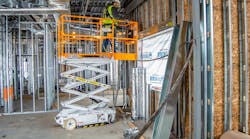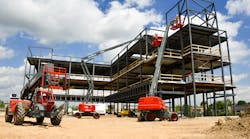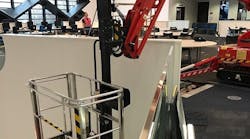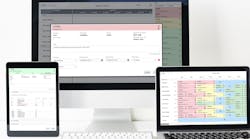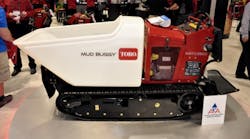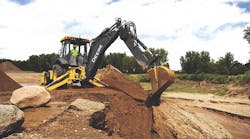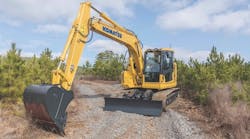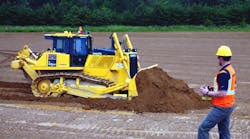Recent
Interviews with Earthmoving Manufacturers: Intuitive Machine Control
Earthmoving equipment manufacturers take a look at how technology is developing, advances in telematics, the growth of hybrids, connectivity, shifts in demand and a whole lot more.
Participants:
Corey Rogers, marketing manager, Hyundai Construction Equipment Americas;
Eric Yeomans, GPPE product manager, Volvo CE;
Aaron Kleingartner, Doosan Construction Equipment marketing manager;
Mitch Tobias, Caterpillar Inc. customer enterprise digital manager;
Steve Brown, Caterpillar, global rental marketing & operations manager;
Jason Hurdis, Caterpillar, senior market professional;
Jay Quatro, Wacker Neuson, product application and training specialist;
David Garton, manager of rental accounts, Case Construction Equipment;
Jason Archbold, marketing manager, Bobcat Co.;
Derek Betcher, marketing manager, rental, John Deere Construction & Forestry
RER: What are the latest technological developments with your equipment?
Rogers: With the new HX series excavators we have increased the automotive style quality of our equipment through improved manufacturing, innovative design, enhanced quality control and new convenience technologies like Hyundai's exclusive Haptic Control module that puts everything at your fingertips. HL900 series loaders and HX series excavators both feature the largest, brightest and most comprehensive full touchscreen color monitors in their respective product classes. AAVM, our exclusive All Around View Monitoring system, is another technology that bridges automotive design with our excavators. This 360-degree surround-view and object-detection system makes the Hyundai excavator one of the safest machines on the market. Other products will feature a similar system in the near future.
Yeomans: At ConExpo 2017, Volvo unveiled a number of new machines, including two new wheel loaders — the L260H and L350H. However, the biggest announcements came in the form of technological innovations – including ActiveCare Direct and a suite of machine control solutions available through the Volvo Co-Pilot interface.
ActiveCare Direct is a telematics monitoring service offered directly from Volvo and supported by the extensive Volvo dealer network. Volvo has built an uptime center with an experienced team of data analysts who provide 24-7/365 active machine monitoring, as well as monthly fleet reports that provide insights that can help improve fleet utilization, uptime and efficiency.
In addition to telematics solutions, Volvo has made strides in providing intuitive machine control solutions for operators to increase accuracy and efficiency on the job site. Using the Volvo Co-Pilot high-resolution touchscreen interface, operators can use programs like Dig Assist for excavators, Compact Assist for asphalt compactors and Load Assist for wheel loaders to see real-time data that helps improve job accuracy.
In the future, customers can expect to see updates to Volvo Co-Pilot options, and new solutions for other machines, including articulated haulers and soil compactors.
Kleingartner: Doosan excavators offer the ability to control the auxiliary hydraulic flow and pressure for multiple attachments. A rental store can set the maximum flow and pressure for the attachment that is paired with the Doosan excavator going out on rent. For example, if a customer rents an excavator with a hydraulic breaker, the rental store can set the maximum flow and pressure for use with the breaker. Too much flow can be detrimental to the breaker. The same can be said for other attachments, including a hydraulic clamp. Rental stores can adjust the flow and pressure from the settings for use with a hydraulic breaker to the hydraulic clamp.
A growing trend with earthmoving equipment – articulated dump trucks, excavators and wheel loaders – is the ability to remotely monitor it. This is commonly known as telematics. For example, a rental store can remotely monitor a machine for any errors/faults, as well as keep tabs on a machine’s location. Some telematics systems allow owners to set geofences around equipment. When the equipment goes outside of the geofence, the owner is notified via email or text message.
Tobias: We recently launched our 988K Wheel Loader and D8T Dozer remote control systems as a part of our Command technologies.
Quatro: Wacker Neuson is doing a lot with software-driven controls in our new medium frame skid steers and track loaders. Not only can operators switch between control patterns (ISO and H Pattern), they can select from a range of sensitivity levels for both drive and work functions. This is especially useful for rental fleets where each operator may have a different preference.
Garton: Some of the greatest advancements in our equipment have been in telematics and machine control technologies. From the rental standpoint, what we've been working on is getting the customers to use it. It’s one thing to have SiteWatch on all of your machines—and our rental customers could have 500 of our machines—but if they don't use it then it doesn’t do any good.
We're working with them to get the data that they need. Things like blade control with GPS on the dozers—they know it's there, but it’s being underutilized, so it's a matter of helping our dealers and end users understand what they already have available to them.
Other advancements have stemmed from the continuous improvement on the engines and the emissions through the Tier 4 mandate. Tier 4 has really made manufacturers take a closer look at how all the different systems—the engine, hydraulics, electrical systems etc.—work together in order to get the best performance out of a machine.
Archbold: For Bobcat skid steer and compact track loaders, several new technological developments have been added to the machines in recent years which provide operators better comfort and performance.
Automatic ride control, launched on the M2-Series loaders allows operators to use a switch inside the cab to toggle between auto and off. When auto mode is selected, the system will work at any travel speed. The automatic ride control function is activated by detecting increased hydraulic lift arm pressure when the loader is carrying material. It will automatically deactivate when hydraulic lift arm pressure is reduced – such as grading when there is no load in a bucket. This reduces material spillage, allowing operators to travel at faster speeds for increased productivity. Thanks to its dampening effect, the option also increases comfort by offering a smoother ride, and is optimized for each Bobcat loader frame size. This improves ease of operation for the operator as it engages when needed and disengages when not needed regardless of machine speed.
The reversing fan option, also launched for use with M2-Series loaders, allows operators to temporarily reverse the cooling fan direction – for several seconds – to blow dust and small debris from the radiator and rear screens. The reversing fan option helps minimize downtime and can reduce the cooling area cleaning frequency. Operators can choose from the following three operating modes:
- Automatic: Reverses fan direction at a regular frequency to keep the loader’s engine coolant and hydraulic oil at proper operating temperatures
- Manual: Purges material at the operator’s discretion
- Off
The new R-Series compact excavators, launched at CONEXPO 2017, provides many technological updates to operators. Just like Bobcat Selectable Joystick Controls, R-Series compact excavator fingertip controls allow for precise work and ease of use. A new secondary thumb toggle lets operators switch between the second auxiliary hydraulics and the boom-offset without letting go of the joystick. That means operators don’t have to stop what they are doing to search for the switch since it’s located on the left joystick.
Betcher: Interest in and usage of integrated grade control machines continues to grow daily. Our 700K, 750K, and 850K SmartGrade™ dozers improve jobsite accuracy and quality of work through their complete integration of the Topcon 3D-MC2 Grade Control System. The system is fully integrated into the machine cabin, structures, and software – delivering precise grading performance while eliminating vulnerable external masts and cables.
By combining the power of Topcon technology with the John Deere track load sensing system, the SmartGrade dozer offers an easy setup, highly productive grading machine intended for road building, site development and residential building customers. These purpose-built machines are ready to work the moment they leave the dealership, and the complete system is sold and fully supported by the world-class John Deere dealer network.
Machine monitoring is a hot topic today as well. Located inside the mile-long Dubuque Works facility, the newly minted John Deere Machine Health Monitoring Center is changing how John Deere and its dealers analyze data and proactively support customers through mainstream technology. The Machine Health Monitoring Center is situated in close proximity to product engineering teams, as well as the men and women who build many of John Deere’s construction and forestry machines. It is also the home to John Deere WorkSight™ solution engineers and product support experts. Within the Machine Health Monitoring Center, specialists with a deep understanding of the equipment and expert analytical capabilities develop solutions that nourish the manufacturer’s monitoring services by analyzing aggregated machine data, identifying trends that warrant a closer look and then developing new and improved preventative maintenance and repair protocols.
Working in tandem with the Machine Health Monitoring Center are Machine Monitoring Centers at dealerships across the Americas. These centers feature trained dealer specialists who use advanced telematics and alert management tools to stay on top of potential issues. When necessary, they can engage trained technicians who are armed with the capability to read and clear diagnostic codes, record machine performance data and even update software — without ever visiting the machine in the field. Response time is quick, and, many times, problems can be addressed before they cause downtime. When technicians visit the machine, they can often arrive with the parts in hand to make the repair.
What trends do you see and do you expect to see in earthmoving equipment in the near future?
Yeomans: The availability of machine control systems is increasing, such as the Volvo Dig Assist and Load Assist programs available on the Volvo Co-Pilot interface, which allow operators to input job parameters and see real-time data to ensure the job is done right the first time — minimizing errors and the need for rework.
Volvo Load Assist is available on the L110H-L250H Volvo wheel loaders, and provides real-time payload data and work order management functionality to the operator, as well as documentation of work orders for owners and customers. With the 10-inch, high-resolution Co-Pilot interface, the operator can set up projects in just a few touches by selecting the customer name, work order number, target tonnage and material type. Once all the parameters are set, the operator can track progress in real time as the job is underway. The display shows tonnage currently in the bucket, tonnage already delivered to the truck (or other delivery location) and tonnage left to be delivered to complete the job.
Volvo Dig Assist is an intuitive excavator machine control system that allows operators to easily input job specifications and track progress along the way to ensure the job is done right the first time, every time. The operator can see the real-time position of the bucket and machine in relation to target grade and depth. With the optional In-Field Design functionality, the operator can draw custom digging profiles directly from the cab.
Kleingartner: I expect more remote management and visibility to the earthmoving equipment, as well as other equipment on the jobsite. In other words, how are the machines working together (in tandem). I see continued automation, in terms of when an articulated dump truck is full and where the truck is located.
Tobias: We would expect the use of technology in many areas to continue to increase and become more common practice. Some of the most recent advances that would be built upon are Grade Control, Payload, and Intelligent Compaction. Customers will continue to migrate to the use of these tools to assist in improving productivity, lowering material costs, increasing safety of their workforce, and reducing time of projects. A great reference video is: https://www.youtube.com/watch?v=6nF2YIf9r-k&feature=youtu.be
Quatro: Telematics and GPS machine control are becoming more popular throughout the equipment market. As technology advances, telematics reporting has become more robust. These go beyond simple location services. On our new medium-frame skid steer and track loaders, we now offer a Deluxe Telematics package. This features remote monitoring of over 20 different machine functions and systems other than just GPS location. I would expect to see more advanced systems moving forward made available from manufacturers directly in additional to existing third party solutions.
Garton: It’s important to have an understanding of the market mix. Most people think of rental as mini excavators, skid steers and other small equipment. I'll be honest, I think we've sold more heavy equipment this year that anything to the rental companies—full-size crawler excavators, large wheel loaders, dozers and things like that. It’s in response to the demands of the market.
That means contractors are starting to clear land, they're starting big projects and the smaller equipment is used to finish up those projects and once they're done, those smaller machines are used for landscaping, pools and things like that. In the future, I see both manufacturers and rental companies getting smarter about forecasting those needs based on different market conditions.
Archbold: Connected machines, also known as telematics, is the next big thing coming with compact equipment. A connected machine can provide machine location, diagnostics, maintenance reminders and more.
In addition to connected machines, we are seeing a shift toward “smarter” horsepower in compact excavators. As new compact excavators are launched there is a trend toward less horsepower, but performance continues to be the same or better. In the popular 2-3-ton size class Bobcat Company offers the R-Series E35 in a 24.8 horsepower or 33.5 horsepower model. This provides customers with options – depending on job needs – to select a compact excavator in this size class.
Betcher: As mentioned previously, John Deere SmartGrade dozers are gaining traction in the construction market, and we continually evaluate whether this technology would be useful for customers in other dozer sizes. The 950K is one such example. Customers are interested in machines of this size class – 265 horsepower – not only to move earth, but for precise grading on large projects.
Rogers: Machine guidance and expanded telematics capabilities are all fast moving technologies that Hyundai is pursuing with great intensity.
There was a lot of interesting technology at the Conexpo show, such as use of drone technology in earthmoving equipment, virtual reality training and more sophisticated use of telematics. What were some of the new technological advancements you have made?
Kleingartner: Doosan continues to enhance its telematics offering to customers who purchase excavators, wheel loaders and articulated dump trucks. In terms of the rental market, we expect continued development in machine-to-machine communication to improve operating efficiencies on jobsites, especially when two or more machines are working together.
Tobias: Also at the show, we had a D8T Dozer located in Peoria, IL being controlled remotely from the operator station at the exhibit in Las Vegas. The new Cat Command remote control system for the D8T offers a choice of two operator interfaces--- a portable operator console designed for line-of-sight use and an ergonomically designed operator station that can be located remotely when the dozer is equipped with the Command Vision system. Wireless connectivity enables the operator to work from a safe location, whether nearby or far away. Additionally, we demonstrated a remote control skid steer loader at Conexpo as well.
|
Garton: As far as technology in the rental industry, manufacturers have communicated what is available and now we're seeing the rental companies start to tell us what they really need, and how they use those advanced technologies. In regards to telematics, many rental companies are utilizing that data to help them stay on top of planned maintenance. Telematics data can help rental companies forecast, stock replacement parts ahead of time and stay ahead of the curve when it comes to properly servicing their equipment and maintaining profitability. That's where the rental companies are seeing what we can offer, and they want that kind of data loaded into their systems. |
Archbold: At ConExpo 2017, Bobcat used a virtual reality station to provide attendees a real look at how a Bobcat loader works. Not only is this useful to show how our technologies work, but it’s also a good way to train new operators or test new technologies before they are in the field. This provides the advantage of speeding up the product development process and providing new training methods.
Betcher: With the Kespry Drone 2s now available across the John Deere network, customers can easily create a mission with the touch of a finger, then capture, analyze and share survey-grade data and insights. The post-processed data is accessible from anywhere in the world via an easy-to-use web interface, allowing customers to access real-time 3D renderings, volumetric analysis and data export features with the click of a button. The drone-collected data can then be exported from the Kespry cloud to a number of common modeling packages including AGTEK Earthwork 4D, another endorsed John Deere solution to perform 3D model overlays, cut/fill maps, bidding and takeoff procedures.
As described above, the John Deere Machine Health Monitoring Center and Machine Monitoring Centers were a big part of our CONEXPO presence as well.
Rogers: Recently our proprietary Hi-Mate telematics system was upgraded to offer operators, owners and fleet managers even more valuable information on their equipment through our new Hi-Mate 2.0 system. We also innovated and launched a new mobile app designed for quick access to Hi-Mate on the go - currently available for android phone users only.
It appears that hybrid machines are now more popular than in the past? Do you find more of a demand for them in the rental market?
Brown: From an OEM perspective, we see rental demand often mirrors retail. Hybrid machines are becoming more popular in rental fleets as customers are seeing value in the technology.
Quatro: We have seen a demand in the rental market for our small hybrid excavator, the 803 Dual Power. This unit can be run on either diesel or with an optional hydraulic power pack for zero emissions operations. This flexibility allows a rental house to cater to both customers with one machine.
Betcher: While the interest in hybrid machines is growing, compact equipment tends to be a more popular option in the rental segment, and these machines don’t burn as much fuel compared to their larger counterparts. We think there’s a place in the market for customers interested in hybrid machines, and for customers that want the extra productivity advantages and operating cost advantages. Customers that closely track their operations will most appreciate the benefits of lowering operating costs. However, a short term renter will have different value drivers, and many prioritize equipment reliability, versatility and ease of use. A higher acquisition cost for the increased productivity and fuel savings of hybrid machines may appeal less to the rental market, which has focused on traditional powertrains.
Yeomans: We can’t speak to the popularity of hybrid equipment for the rental sector, but Volvo is always experimenting with new technology, including creating hybrid and electric concept vehicles. For instance, the Volvo HX02 concept battery-electric, fully autonomous load carrier made its first public appearance at CONEXPO-CON/AGG 2017. Previously, the Volvo Concept Lab unveiled the LX1 electric hybrid wheel loader concept vehicle, and in May 2017, they unveiled the EX2 compact excavator — what is believed to be the first fully electric compact excavator prototype.
Kleingartner: Overall, we do not see an increased demand for hybrid machines in the rental market. In certain applications, a customer who needs to supplement his or her earthmoving equipment may request a hybrid machine; however, earthmoving contractors who rent machines are typically more concerned about how much material they need to move. Often times, they are supplementing their fleet to get a specific job completed where production is a higher priority.
Are you finding increased demand for any particular kinds of machines from the rental market?
Quatro: The rental market is increasing their demand for a wider range of machine sizes. As a manufacturer, we are constantly re-evaluating our line-up to ensure we can meet each segment of the market. As a result, in the last two years, we added six new skid steer and track loaders, a 14.5 ton excavator, and two ground-engaging telehandlers to our already extensive line-up to further meet the needs of a broader customer base.
Garton: The sales numbers in the rental industry are showing growth in demand for larger machines. You might look at that and say that it could be due to aging rental fleets needing replaced, but in the rental companies that I have talked to, that's certainly not the case. They need the gear. They need more and more excavators and dozers and other large earthmoving equipment in order to respond to the changing needs of the market.
|
|
|
In regards to demand in the rental market, there has been talk over the last several years about the backhoe going away and being replaced by mini excavators and compact track loaders. Interestingly enough, over the last five years, the industry sales for backhoes have remained perfectly flat. Backhoe sales have not gone down like everybody thinks, but compact track loader and compact excavator sales have gone up exponentially. There is simply a growing demand for smaller equipment.
|
This makes perfect sense in the rental industry. A rental house can buy a mini excavator and a compact track loader for the same price as one backhoe, and the rental rate on a mini excavator and a skid steer is the same as the backhoe. For example, say the rental rate on a backhoe is a $1,000, the rental rate on a mini ex is a $1,000 and on the track loader it's a $1,000. From an investment standpoint, it makes sense to buy the small stuff. If I buy two machines for the same price as one, but I can double the rental rates, I could double my profitability.
Archbold: With younger operators entering the market there is a trend toward all hand controls like Bobcat Selectable Joystick Controls compared to traditional hand and foot controls. Younger operators didn’t necessarily grow up with hand and foot controls, and because of this prefer solely to use their hands to operate compact loaders. This is not only easier for them, but also reduces fatigue and increases productivity because of the ease of use and added operator comfort.
There is also a shift toward the adoption of compact track loaders in rental fleets as they can be used in conditions where a skid-steer loader may not be able to operate, such as wet or soft ground conditions. The acceptance of compact track loaders in the rental industry means a greater utilization of customer’s rental dollars, and greater performance in many applications.
Betcher: We’re seeing a strong, steady growth in demand for mini excavators and CTLs in the rental market. Both of these product families are at record high industry levels in North America. In additional to the continued strength in the compact equipment market, we’re seeing good activity in the excavator market, and notable growth in the six to 10 metric ton range where John Deere offers the 75G and 85G models.
Rogers: The rental market is continuing to grow and projected to increase year over year for the next 3-5 years. We are seeing most of the growth in the largest volume market - compact equipment - which includes our 9A series compact excavator product line and small hydraulic breakers. However, as pipelines open up and coal recovers and other oil and gas or energy-related businesses grow, we see dealers and customers increasing their rental fleets with larger excavators and loaders to meet growing demand for those machines.
Yeomans: We continue to see compact excavator growth, with recent data showing that customers are selecting compact excavators to replace the role of a backhoe. Volvo is dedicated to continuing our growth in the compact excavator market so that we can be a one-stop shop for any customers’ application needs.
Kleingartner: There is an increased acceptance and use of reduced-tail-swing crawler excavators in the rental market. Infrastructure work, such as repairing roads and bridges, is better suited for reduced-tail-swing excavators because it requires fewer lanes of traffic to be closed. Reduced-tail-swing crawler excavators have typically been on the smaller size; however, during CONEXPO, we saw some companies introducing larger reduced-tail-swing excavators – as large as 30-metric tons – to accommodate the growing demand for this style.
Brown: We are seeing an even distribution in demand across our product segments. Increased investment in infrastructure and commercial construction are pulling products across our portfolio into dealer rental fleets.
What kind of knowledge of technology is necessary for rental companies to help their contractor customers?
|
Garton: One of the big challenges in the industry now is understanding the different Tier 4 solutions. As manufacturers, we know about all the different Tier 4 systems, and we know what you have to do to keep them running efficiently. A big part of my role at Case is going out and training the rental companies on these new technologies. This is what you need to know about tier 4, this is how you keep it running. The big key though, is the end user. The guy that actually gets in the seat and has to fill up the gas—and DEF—tanks every day. If he doesn't know, it's not going to get done. The same with telematics systems that may be on the machine. We know it's there, some people at the rental company know it's there, so our challenge is to help them get that information to their end user. |
|
With telematics, you know what time the operator turned the key on, you know how much fuel he burned during the day, etc. The guy that's going to start to make an impact using telematics, from the rental standpoint, is the guy who can figure out how to effectively feed that data to their customers. If you can put on that invoice, automatically, this wheel loader ran X number of hours, burned X gallons of fuel, traveled X amount of distance and moved X amount of material—when you start feeding that productivity information to customers, that's when you start to win. That's when customers start to look at your rental company and say, "I don't get this from anybody else, what else can you tell me?" As far as technology moving forward, all the pieces are in place, now it's just about tying it all together and getting the rental companies to use it in a way that works for them, and getting them to feed that to the end users to help them manage their businesses better. |
|
|
|
Archbold: Contractors who rent compact equipment may know what technology is out there, but that does not necessarily mean they know how to use it or know what it could mean for their business. If a rental company can provide a good background of machine features, including new technologies, it will help the customer achieve the full value of the machine (for a better user experience). This means maximizing the rental dollars used, but also will help minimize damage to a machine that may happen if the customer does not understand how to use the features and technologies correctly. Betcher: The feedback we’ve received from independent rental companies is that their rental customers often prefer simpler machines. The independent rental companies rent to such a broad group of customers. It’s not just earth moving contractors, homebuilders and roadbuilders, but institutions, industrial sites, electricians, plumbers and other tradesmen, and even homeowners. Many customers who choose to rent equipment have only a short term need for it and may not be in the main business of operating or maintaining equipment, at least not compared to those who work with machinery as part of their fulltime job. We have seen product features like simple, intuitive controls, good visibility and easy transportability are preferred. And rental companies prefer equipment that is easy to keep on rent. We know they have a huge variety of manufacturers and powertrains in their fleets, and their technicians need to be jacks of all trades. Extended service internals, excellent maintenance and repair access, easy to use onboard diagnostics, and overall product quality and durability are important must-haves for many rental houses. Rogers: Hyundai machines are simple to operate but have the technology for sophisticated customization if the application requires. If a rental company wants the machine to default to specific settings, with both the HX series excavators or the HL900 series loaders, a fleet owner – either alone or with expertise provided by the Hyundai dealer - can easily select User Mode settings and instruct rental customers to only use User Mode for maximum performance and ease of use. Yeomans: It’s important for rental houses to stay up-to-date on current and emerging technology trends, because customers often first look to rental houses for assistance in picking out the best equipment, even when it comes to making sure they understand what equipment would be best to meet their needs prior to bidding jobs. First, customers learn they can become more efficient on the job site using new technologies such as the Volvo Co-Pilot suite of programs — Dig Assist for select excavators and Load Assist for select wheel loaders. Second, customers can test programs before making purchasing decisions, ensuring the return on investment for the technology. Kleingartner: One of the challenges faced by rental companies is the variance between manufacturers and how to program certain machine features. Earlier, we explained how a rental store can set the maximum flow and pressure for an attachment to protect the attachment from potential damage during the rental. This process can vary among manufacturers and make it difficult for rental stores to know how to program each machine. Generally speaking, customers renting an earthmoving machine are likely supplementing their existing fleet to help complete a project or are renting a machine for a niche application. They’re looking for a machine that is reliable and durable, and will help contribute toward finishing a project on time. Rental customers are probably not looking for a machine with the newest gadget or accessory because it’s all about productivity from a quality product. Brown: Customers interested in productivity have a strong preference for technology enabled solutions. Also, regulatory compliance, such as Tier 4, adds new technology to machines. Rental companies now become a key partner in helping customers understand and optimize these technologies. It’s critical that rental companies train their teams to become a trusted advisor to customers when it comes to technology. Quatro: Rental customers want simple machines that will increase their productivity. As manufacturers, the challenge is to include the latest technology and features, while reducing the learning curve for the end user. One issue that has been prevalent across the industry for the past few years is Tier 4 Final engines. This has increased the complexity of machines on the market and does require the rental company to educate their customer on different after-treatment systems, depending on manufacturer and model. Wacker Neuson addressed this with our new medium frame skid steer and track loader machines. The Tier 4 Final Kohler engine we use was engineered from the ground up to meet the latest standards with a maintenance-free and regeneration-free after treatment system. This eliminates the need for rental companies to educate their customers on regen lights, switches etc. before each rental.
|
|
How have machines improved (or not improved) with the advent of Tier 4 technology? Archbold: Tier 4 technology allows manufacturers like Bobcat Company to design and build more efficient compact equipment. Tier 4 emission technologies help increase performance, such as boosting torque output from the engine. In addition, new technologies lower operating costs for better fuel efficiency. A more thorough combustion process produces cleaner exhaust, while less engine noise increases operator comfort. Betcher: The advent of Tier 4 brought several advances and improvements to equipment along with meeting the required emissions regulations. For one, we extended service intervals on many models of Deere equipment to maximize uptime and help lower operating costs. But like many improvements, also comes the need for customer education. DEF may be new to someone who is renting higher horsepower diesel-powered equipment for the first time and some renters may not be aware DEF needs to be added to certain machines the same as other daily fluid checks like fuel. Other models may require regeneration. While Deere equipment keeps operating during this automated exhaust filter cleaning process, the regen notification light on the monitor could mistakenly alarm a new operator. It’s important for the rental house to educate the user about these functions. To help fleet owners manage these features, machines equipped with telematics can help alert the rental company if regen has been overridden or other operator or maintenance issues are popping up on the machine.
|
Rogers: With every new series - independent of Tier 4 Final evolution - new features, technologies, quality improvements and performance improvements come about. Tier 4 Final engine technologies have pushed the boundaries of environmental responsibility, increasing consumer awareness of protecting their environment, which is great for everyone. As engines and emissions restrictions are increasingly more strict, additional importance was placed on engine "ECU" communication and corresponding engine performance data availability to operators, fleet owners and equipment manufacturers. The integration of all systems has continued to improve.
Yeomans: With Volvo’s expert engineering, we’ve considerably lowered horsepower on some models of skid steers and compact excavators — meeting Tier 4 emissions standards — while still improving the performance and power of the machine. The engine and hydraulics work in concert to increase performance. For example, improvements in compact excavator hydraulics result in increased lift capacity and breakout/tear out forces while remaining in the required horsepower range to meet Tier 4 emissions regulations.
On Volvo excavators, the advent of Tier 4 technologies coincided with the release of the Volvo positive control hydraulic systems, which drastically improve the ability to control machines while delivering significant fuel savings. Additionally, the transition to electro-hydraulic systems also enables the use of response modes, which allows operators to customize how fast the machine reacts to operator control input on the joysticks.
Engine and hydraulics are closely related and are very significant in pushing the market to evolve. Due to recent changes in emissions regulations, manufacturers need to look for ways to stay within the horsepower ranges without requiring any additional purifying systems on the machines. To achieve this, engineers must match engine power with the hydraulics — ensuring enough hydraulic power to operate the attachment, while getting the same or better overall performance.
Kleingartner: Interim Tier 4 and Tier 4 emission standards not only improved air quality for everyone, they allowed manufacturers to introduce product enhancements that increase performance, productivity, operator comfort and fuel efficiency. For example, continued enhancements to fuel delivery systems allow engines to work more efficiently and deliver more usable power to the machine’s systems; thereby increasing the operator’s productivity. In other words, the operator can get more work done in less time because the machine performs at a higher level of performance.
Quatro: The obvious improvement with Tier 4 technology are cleaner burning diesel engines. These engines are also more fuel efficient than older models. The industry-wide EPA mandate forced equipment manufacturers to redesign their machines in order to be compliant. As a result, we’ve seen a lot of fresh, new machines hit the market along with the latest features and technology. Tier 4 emissions requirements was the push the industry needed to feed more investment in new technological innovations and machine designs.
Garton: Machines have improved greatly with Tier 4 technologies. The environmental impact aside, what Tier 4 and this whole EPA emissions thing has made manufacturers do is really take a good hard look at how our machines operate. It used to be, you threw an engine in and you hooked it up and it ran. Well now, everything has to work in harmony. You have to maximize the output of the hydraulic pumps because maybe your engine isn't running at the higher horsepower that the previous model used to. You really have to take a look at the whole machine and make sure it runs extremely efficiently.
All the engines are computer controlled now, and I don't think you could tune and engine any better to be any more fuel-efficient. Then with Tier 4, all the stuff that we know we have to measure, again, the manufacturers had to look at their machines, look at their data and output and say, "We need to get better." I'm not sure that the industry has ever had to do that before.
We all remember seeing black smoke coming out of the exhaust pipes on some of these machines. Those days are gone, because we had to take a good hard look at the way our machines performed, and we realized that there's a better way to do this.
Are earthmoving machines more fuel efficient than in the past? If so, how, and to what degree?
Archbold: Machines are more fuel efficient today, especially as technology plays a larger role. With smarter horsepower, you often get the same horsepower and engine displacement but delivering more performance without sacrificing fuel efficiency. Additionally, we are seeing smaller horsepower engines in popular size classes like the 3-metric-ton class (Bobcat E32 and E35). These machines provide high quality performance, but at a smaller horsepower thus lowering fuel consumption.
Bobcat Company also provides an auto-idle function for compact excavators and loaders. When machine functions aren’t used for approximately four seconds (or an adjustable time period with the Bobcat Deluxe Instrumentation Panel), the machine automatically idles the engine until work resumes reducing fuel consumption. When the joystick controls or travel is initiated, the excavator or loader automatically returns to the previously set throttle position.
Rogers: Hyundai's new HX series excavators and HL900 series wheel loaders are on average - depending on model - around 10-percent more fuel efficient than previous models. Fuel consumption and efficiency continue to be design priorities for Hyundai as we look to a cleaner environment and a more profitable value proposition for our customers.
Yeomans: Across our entire lineup, each new model series comes with both increased fuel efficiency and increased performance. For example, our ECR235E and EC160E excavators are equipped with a Volvo Tier 4 Final engine that delivers up to 10 percent fuel economy improvements over previous models. To boost productivity and efficiency, machines offer integrated working modes, which allow the operator to choose the best work mode for the application — I (Idle), F (Fine), G (General) or H (Heavy). To further improve fuel efficiency, these machines are equipped with auto idle and engine shutdown features. A winning combination of enhanced hydraulics, improved ECO mode and convenient service access contribute to lower overall costs and higher productivity.
In the H-Series wheel loaders, including the L110H-250H, Volvo has implemented a dry parking brake in line with the efforts to reduce fuel consumption, as an external dry disc parking brake eliminates drag losses caused by the internal wet multidisc. In addition to fuel efficiency improvements, the dry parking brake is easier to maintain versus the wet parking brake, as it’s located externally for easier access. There is a new gear ratio in the transmission, so the gap when changing gears is much tighter, which gives the wheel loaders faster acceleration and improved hill climbing performance, and better fuel efficiency. In models L110H-L250H, Volvo has upgraded the torque converter to improve fuel efficiency in the bucket filling phase and more rim pull for stock piling. Volvo has also released the high performance bucket, rehandling bucket and rock bucket for its wheel loaders, which have contributed to significantly improving productivity and fuel efficiency.
On our latest G-series articulated haulers, Volvo Dynamic Drive is a new software and hardware update that allows the engine to be able to take information from the onboard weighing system, and will know how much weight is in the bed, how fast the machine is going, what gear the operator is in, at what inclination up or down hill, and will automatically select the most fuel-efficient transmission gear. With Dynamic Drive, customers can expect a 3 to 10 percent fuel efficiency improvement, depending on the model.
Kleingartner: Yes, Doosan earthmoving machines continue to improve fuel efficiency from prior generations. For example, from Tier 3 to Tier 4 machine iterations, Doosan machine fuel efficiency improved between 5 to 10 percent.
Hurdis: Earthmoving machines produced in the last two years are significantly more fuel efficient than previous machines. Fuel consumption reductions have come from advantage powertrain systems such as our XE’s platforms, hydraulic system improvements, cooling system improvements, engine improvements and basic technology controlling all the systems for maximum production with the least amount of fuel consumption. As a general statement, today’s machines are easily 10% more fuel efficient than previous machines with gains up to 25% on specific machine platforms.
Quatro: With the implementation of Tier 4 final engines, we’ve seen an overall increase in fuel efficiency. We also have other features built into some of our machines to save fuel. On our larger excavators for example, we include auto-idle and an ECO mode as standard features. When combined with the Tier 4 engines, we have seen up to 20% reduction in fuel consumption over previous models.
Archbold: Machines are more fuel efficient today, especially as technology plays a larger role. With smarter horsepower, you often get the same horsepower and engine displacement but delivering more performance without sacrificing fuel efficiency. Additionally, we are seeing smaller horsepower engines in popular size classes like the 3-metric-ton class (Bobcat E32 and E35). These machines provide high quality performance, but at a smaller horsepower thus lowering fuel consumption.
Bobcat Company also provides an auto-idle function for compact excavators and loaders. When machine functions aren’t used for approximately four seconds (or an adjustable time period with the Bobcat Deluxe Instrumentation Panel), the machine automatically idles the engine until work resumes reducing fuel consumption. When the joystick controls or travel is initiated, the excavator or loader automatically returns to the previously set throttle position.


